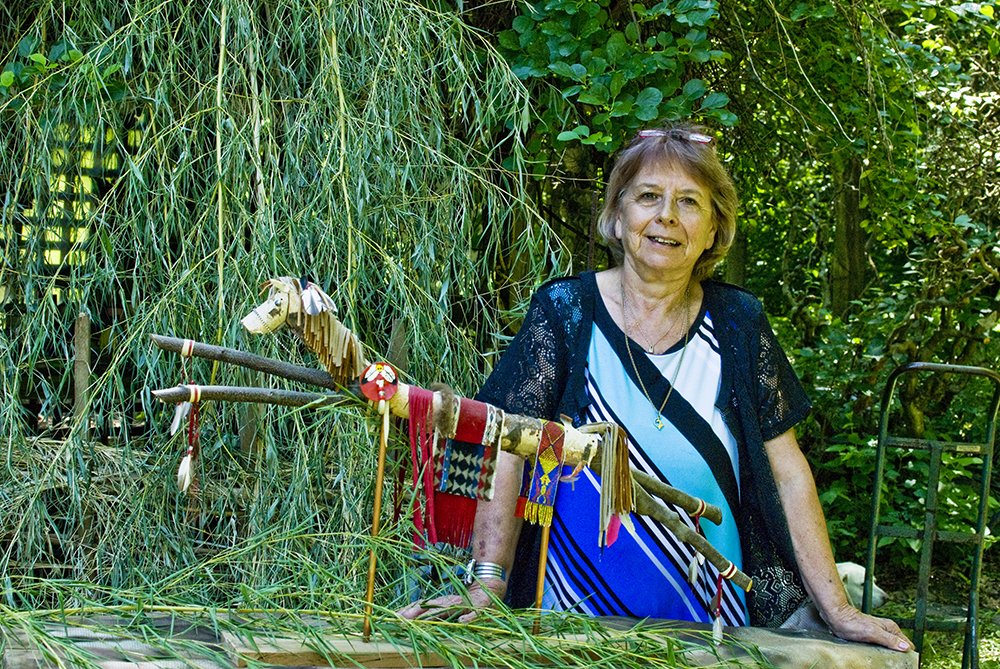
Eliida Lakota created “spirit horses” that were given to speakers at a water protectors conference in Minneapolis recently. She said Native American art is infused with symbolism and helps people connect with the sanctity of nature. Art played a role, Lakota said, in the victory against the Dakota Access Pipeline. (PHOTO BY CLARE HOWARD)
Eliida Lakota grew up understanding the sacred nature of the environment. When her father came home from work, she and her parents would walk to the Sangamon River. Her father would identify trees and flowers along the way. They would talk about protecting nature — about only picking flowers that were abundant and never picking flowers that felt resistant to her tug. Always be conscious of what is going to seed for the next generation.
She said she learned “plant lives matter.”
Lakota is Native American and all of her artwork today is infused with symbolism.
She was a clinical supervisor for occupational therapy students for decades. She developed expressive art treatments for mental health and eating disorders.
“With eating disorders, expressive art treatments help with body image,” Lakota said. “Sometimes people can communicate complex emotions with pictures but not with words.”
She has taught children on reservations out West and in workshops on the East Coast, and is always surprised to learn how many have never made a medicine bag or a dream catcher. They do not know the history of spirit horses and spirit dolls, dance sticks and prayer sticks.
“Children are very expressive through art. They can develop a stronger self-concept and understand themselves better through expressive arts. They can express feelings in a non-aggressive way through art. Art comes from a deeper place,” she said, noting that rowdy, disruptive children often become focused and eager to learn about Native American art and its symbolism.
In the 1800s, many Native people did not have a last name, Lakota said. The federal government told them they could select a last name or the government would assign them one. Young men, her ancestors among them, selected the name of their tribe for their last name. Her last name came from this decision made by past generations of her family.
Lakota said Native American art layers practical, utilitarian uses with aesthetic beauty and spirituality.
“It’s in our DNA to be creative. When people were locked on reservations and couldn’t hunt for deer anymore, the government gave them muslin,” she said. “That became the ‘ghost dress.’ We learned to use what we had.”
She said reservations in the Black Hills of South Dakota should never have been called reservations because they were prisoner of war camps.
“We were put there to die, but we figured out how to live,” she said, and art played a role in that survival.
Lakota was instrumental in bringing the concept of the “REDress” art exhibit to Dayspring United Methodist Church in East Peoria last year. The exhibit was originally created by Canadian artist Jaime Black as an expression of grief for the thousands of missing and murdered Indigenous women.
The exhibit uses red dresses to symbolize the tens of thousands of native women who have disappeared through violence and human trafficking. Estimates indicate 10 times more Native American women are murdered than other women and four times more are sexually assaulted. (Lakota is in touch with Shima Rostami, a researcher and program developer in St. Louis, who has created a training course for people working on issues involving missing and murdered women.)
The REDress exhibit opened at the Smithsonian National Museum of the American Indian last year. Museum deputy director Machel Monenerkit said, “Art transforms, and definitely transcends, and moves our perspectives of how we face a tragedy.”
Lakota said, “Expressive art gets to the root of your personal issues and your values and who you are. It helps you become truly human. People often can’t talk about what is wrong, but they can express it with art.”
She said expressive art includes pictures, writings, music, dance, pow wow and natural gardening among other forms of expression.
Lakota, whose husband Bruce Knoll died in 2018, includes hospice among forms of expressive arts that can help heal, comfort and promote understanding.
She is a “water protector,” first with sweeps along the Illinois River collecting garbage, later with Emiquon Nature Preserve and recently traveling to Standing Rock to protest the Dakota Access pipeline. In a major victory for Native Americans and environmentalists who protested the pipeline, a court ruling issued in early July found the pipeline must be drained of all oil by Aug. 5 and a complete environmental review must be conducted.
Lakota attended a water protectors conference in Minneapolis and made Native American “spirit horses” to present to each speaker. The sculptural pieces were embraced with respect and appreciation.
Yet, she said her art has been referred to as “arts & crafts” and “crap” by people who don’t understand. She has witnessed both professionally and personally that Native American art can connect people with the spirituality of nature. She has been told Christianity goes back farther than Native American beliefs, but she counters the “Good Earth” goes back even further. The Lakota people encourage others to develop rituals to express spirituality. Native art expresses values and is a healing force.
For “water warriors” like Lakota, water is life. Justice was finally achieved in the battle over the Dakota Access Pipeline and art played an important role in achieving that victory.

1 comment for “Art and Justice | Understanding justice through Native American art”